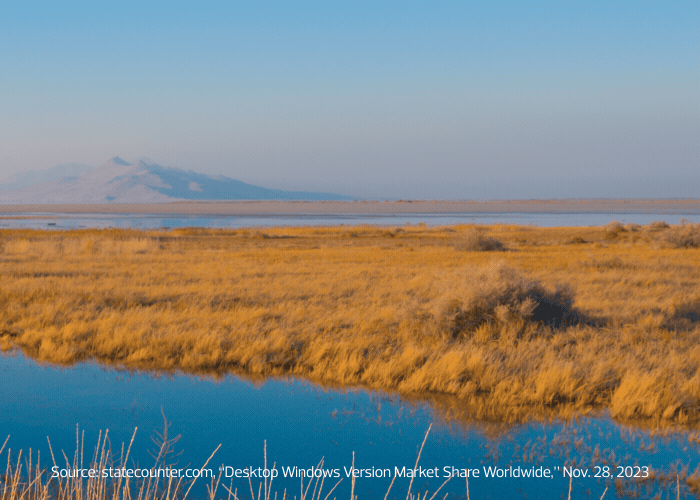With some careful planning, the move to Microsoft Windows 11 should be relatively straightforward, says Utah CIO Alan Fuller. But for those who put the transition off, he says, the effort could quickly become overwhelming.
“This is one of those classic things where, if you take care of business in a timely manner, it will never be a crisis,” Fuller says. “But if you wait until the support deadline hits in 2025 and you try to do it all in one year, it’s going to be a massive crisis. So, we made the decision to get started as early as possible.”
Though most IT leaders will likely find the transition more seamless than with some previous operating system updates, planning, testing and communication are all crucial to the success of the move, says Alan Shark, executive director of the Public Technology Institute.
“The new operating system does expose legacy environments,” Shark says. “There are a lot of applications in areas such as public safety that are years old that are not necessarily going to be compatible. Technology leaders are spending this time trying to assess what they have and working on sandbox situations to test those instances.”
“There’s a lot of equipment and software that is going to require a bit of change, and governments are going to need to make some upgrades and incorporate new APIs,” Shark adds. “There’s some nervousness, and people are taking the move seriously.”
Click the banner below to explore the transition to Microsoft Windows 11.
Utah Prepared for a Smooth Windows Transition
Utah is replacing about 370 Windows 10 computers with Microsoft Windows 11 machines monthly, and the state is updating the operating system for an additional 230 existing machines each month. Troy Black, COO for Utah’s Division of Technology Services, credits the state’s centralized IT services for the rapid pace.
“We have visibility into the machines in each of our agencies, and we’re able to guide them along the way in this effort to make sure that we’re meeting our target date,” he says. “That’s huge.”
The state has proactively communicated with department heads and end users, letting them know what to expect and when. Rather than resisting the change, employees have embraced it, says Rachael Cassady, director of the state IT organization’s desktop group.
MORE FROM STATETECH: Microsoft public sector guru James Collins provides Windows 11 insights.
“Overall, users have been excited about the new features,” she says. “It’s definitely improving security. Better voice typing is a feature that we’ve heard is getting a 10 out of 10 across the board. And then there are little things, such as the simplified interface and improved touch controls.”
Fuller notes that inventorying and asset management have been critical to a successful transition.
“When we first started this, we knew that some of our computers would be compatible with Windows 11 and would only need to be upgraded,” he says. “And we knew that some would not be compatible, and we would have to replace those. But at first, we didn’t know how many of each we had. After we did that work, we were able to put a plan in place to attack those two different vectors. That made a big difference.”
The City of Corona Is Partnering with Users
For Corona, a city of about 160,000 residents in Southern California, the migration to Windows 11 has been largely baked into its move to cloud-hosted virtual Windows desktops. However, the city does maintain around 1,000 physical machines, and Corona’s IT department is halfway through transitioning those workstations to Windows 11.
Many of these physical machines are dedicated to specialized use cases in areas such as public safety, which are more likely to rely on legacy applications. The city is conducting testing and making changes where needed for these more complex cases while also working with users to gradually roll out the new operating system, says Corona CIO Chris McMasters.
“We did lots of very structured piloting, particularly with people who we thought would champion it,” McMasters says. “But we also introduced Windows 11 to resisters to see what they had to say about it. When you have successful pilots, you get people championing the change. They tell the story, and then other people come to us and ask to make the move. It drives its own success.”
This deliberate approach has met little pushback from end users, says Kyle Edgeworth, Corona’s deputy CIO: “Our employees haven’t had a hard time with the adjustment. To them, it looks and feels like Windows 10, so the migration hasn’t been a struggle.”
Corona Systems Administrator Brad Ransbury says that users have responded positively to the security, performance and aesthetic improvements of Windows 11. “They’re getting this new, crisp, clean look, and they’re seeing faster boot times on their physical devices as well,” Ransbury says. “It is also more secure. We’re getting all of the new updates from Windows, and we’re able to tie everything into our Azure Intune so we can deploy security policies.”
IT Leaders are Looking Ahead to Funding Opportunities
Shark suggests that IT leaders use the transition to Windows 11 as an opportunity to try to secure funding for critical updates that their states, cities or counties have previously been reluctant to make.
“In some cases, people are using this move as a means of justifying things that they’ve been asking about for years, where they’ve been met with resistance from senior managers,” he says. “Now they can say, ‘If we don’t fund this, we can’t guarantee the functionality of things like critical citizen-facing applications and human resources systems.’”
“Windows 11 won’t be the end,” Shark adds. “There will be new versions in the future. This is a good time to take a really good inventory and develop a database of where machines are, how they’re supported and what version they’re running. It’s an opportunity to take stock of what you have now and then to develop a playbook for the future.












